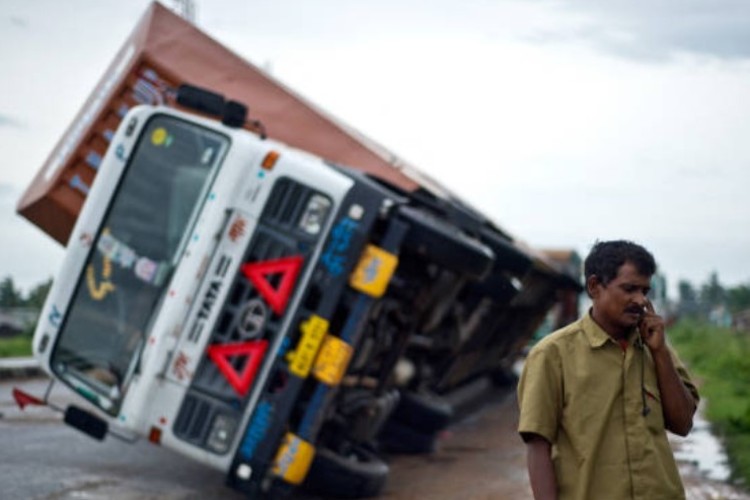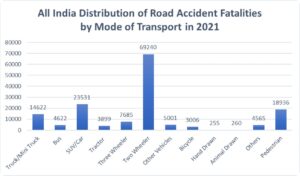
Ensuring road safety in India: The Indian government is considering setting up driving training institutes across the country in response to the alarming rise in road accidents. Acknowledging that a majority of these accidents result from driver negligence, the ministry of road transport and highways has introduced a new policy to establish such institutes. This initiative is a crucial step in a country that records the highest number of road accident fatalities globally, according to a report by the World Economic Forum. India consistently tops the charts for road fatalities, with over 250,000 deaths annually.
While India’s rapidly growing highway network plays a key role in boosting the economy, it also contributes to an escalating number of road fatalities. As highways expand, they increasingly turn into corridors of death, claiming hundreds of thousands of lives each year. Minister for road transport and highways Nitin Gadkari once remarked that more people have died in road crashes than in wars, militancy, and Naxalism combined. He described this as a governmental failure, calling it a “dark issue” for his ministry and a symptom of a society that lacks both “fear and respect for the law.” Experts and policymakers now emphasise the urgent need for a radical shift in India’s approach to road safety.
READ | ASER 2024: A paradox of progress in Indian education
Causes of road accidents
While the staggering number of road accidents in India is well-documented, it is crucial to understand the underlying causes. The challenges are multifaceted, including infrastructure deficiencies, driver behaviour, and enforcement gaps. Poor road design, inadequate lighting, and the presence of accident-prone black spots—dangerous stretches with frequent accidents—worsen the situation. Despite the National Highways Authority of India (NHAI) spending Rs 15,702.80 crore on repairs and improvements over the past five financial years, new black spots continue to emerge. Minister Gadkari himself admitted that the number of black spots is rising due to poorly designed detailed project reports (DPRs) for road projects.

India’s lax traffic regulations further exacerbate the issue. Many drivers routinely flout traffic signals, knowing that enforcement is weak and penalties are minimal. The widespread disregard for road safety rules contributes significantly to accidents.
Objectives of the new road safety scheme
Against this backdrop, the government has announced a new scheme under which the ministry will provide Rs 4,500 crore in phased financial assistance to establish 1,600 driving training institutes across all 36 states and Union Territories (UTs). Currently, India has only 28 functional driver training institutes. The new policy aims to incentivise developers and relax population-based allocation criteria to increase the number of such centres.
Under the scheme, three types of institutes will be developed: Institute of Driving Training & Research (ITDRs), Regional Driving Training Centres (RDTCs), Driving Training Centres (DTCs). Of the 1,600 planned institutes, 26 will be ITDRs, 134 will be RDTCs, and 1,427 will be DTCs.
Shortage of skilled drivers
India faces a severe shortage of skilled drivers, with an estimated gap of 2.2 million. This shortage is a major factor in road accidents, as approximately 35,000 deaths annually result from unlicensed drivers. To address this issue, the new driving institutes will be equipped with modern facilities such as automated driving test tracks, driving laboratories, workshops, simulators, and advanced tools like the Innovative Driving Test System (IDTS). Classrooms will integrate multimedia teaching aids, including TVs, DVDs, computers, and projectors, to enhance learning.
The central government will provide financial assistance for setting up these centres, with capital investment caps set at Rs 17.25 crore for ITDRs, Rs 5.5 crore for RDTCs, and Rs 2.5 crore for DTCs.
Following the initial investment, state governments will be responsible for implementing the scheme. Proposals for these centres can be submitted by state governments, state transport undertakings, transport companies or associations, NGOs, private entities, or other agencies. The development and operation of these centres will follow a public-private partnership model.
While the initiative is promising, implementation has been slow. MoRTH data indicates that 31 IDTRs, 14 RDTCs, and 41 DTCs have been sanctioned, but the completion rate is disappointing. Over the past five years, only two out of 11 sanctioned RDTCs have been completed and started training operations, as revealed in a recent written reply by Minister Gadkari in the Lok Sabha.
The cost of road accidents
Beyond the human toll, road accidents impose a significant financial burden on the economy. The ministry once estimated that road accidents cost India 3.5% to 5% of its national gross domestic product (GDP). This staggering socio-economic impact underscores the urgency of enhancing road safety measures.
While India struggles with rising road fatalities, several countries in the Indo-Pacific region—including Indonesia, Thailand, and Sri Lanka—have successfully reduced road traffic deaths despite increasing motorisation. A prime example of an effective road safety model is Sweden’s “Vision Zero” approach, introduced in 1997. This strategy fundamentally redefined global responses to road safety by declaring that no road-related deaths or serious injuries are acceptable. It prioritises safety above all else and mandates a systemic approach, ensuring that all elements of transportation—including road design, vehicle engineering, trauma care, and legal frameworks—work together to prevent fatalities.
Most high-income nations saw a sharp decline in road accidents post-1960s due to the adoption of scientific road safety measures. A study by the Infravision Foundation in collaboration with IIT Delhi suggests that India must align with global best practices to enhance highway safety. MoRTH must also scrutinise the utilisation of public funds in highway construction to ensure compliance with Indian Roads Congress (IRC) safety standards. Identifying and addressing gaps in contract documents related to safety compliance and liability is crucial to preventing further loss of lives.
India’s road safety crisis demands immediate and sustained action. The new driving training institutes are a step in the right direction, but their effectiveness will depend on swift and efficient implementation. Alongside this initiative, a combination of institutional reforms, technological advancements, and stringent policy measures will be essential to make Indian roads safer. The time to act is now—before more lives are lost to preventable accidents.
